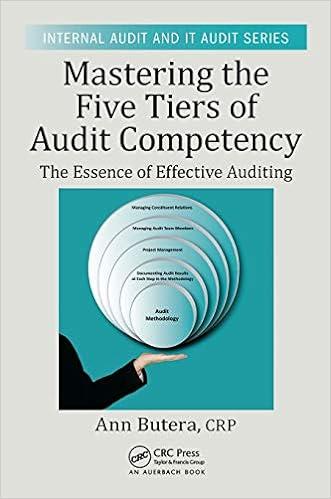Question
1.Financial statements are prepared for an economic business unit that is separate and distinct from its owners. This is referred to as A. the going
1.Financial statements are prepared for an economic business unit that is separate and distinct from its owners. This is referred to as
| A.
| the going concern assumption. |
| B. | the objective of financial reporting. |
| C. | a cost constraint. |
| D. | the economic entity concept. |
2.The cost constraint
| A. | means that assets and revenues should be estimated at the lower end of their range. |
| B. | means that assets and revenues should be estimated at the higher end of their range. |
| C. | means the value of the information is not less than the cost to produce the information. |
| D. | means the information would influence the decisions of a user of the financial information. |
3.At the time of acquisition, long-lived assets are recorded at
| A. | amortized cost. |
| B. | lower of cost and market. |
| C. | at fair market value. |
| D. | at cost. |
4.One criterion for recognition of revenue is to recognize revenue when
| A. | cash is collected. |
| B. | collection is not assured. |
| C. | the seller does not have control over the goods. |
| D. | all sales returns have been returned. |
5.Retailers who sell a product with a warranty period can recognize revenue when
| A. | the warranty period has expired. |
| B. | at the point of sale if the warranty amount can be estimated. |
| C. | when cash is collected. |
| D. | when the exact cost of the items sold is known. |
6.Information is understandable when it is understood by users
| A. | who have a reasonable understanding of financial reporting. |
| B. | who have a reasonable knowledge of business and economic activities. |
| C. | because the information provided is classified, and presented clearly and concisely. |
| D. | all of the above. |
7.The information provided in the notes that accompany financial statements is required because of the
| A. | cost principle. |
| B. | full disclosure principle. |
| C. | matching principle. |
| D. | revenue recognition principle. |
8.Accounting information is neutral if
| A. | it is free from bias. |
| B. | the amount of assets equals the amount of liabilities. |
| C. | the trial balance balances. |
| D. | all of the information is present to show the economic reality of the transaction. |
9. A company can change to a new accounting principle if management can justify that the new principle results in
| A. | more relevant and faithful representation of the financial presentation in the statements. |
| B. | a higher profit. |
| C. | a lower profit for tax purposes. |
| D. | less likelihood of clerical errors. |
10. Relevant accounting information
| A. | is information that has been audited. |
| B. | must be reported within one year. |
| C. | has been objectively determined. |
| D. | is information that is capable of making a difference in a decision. |
Step by Step Solution
There are 3 Steps involved in it
Step: 1

Get Instant Access to Expert-Tailored Solutions
See step-by-step solutions with expert insights and AI powered tools for academic success
Step: 2

Step: 3

Ace Your Homework with AI
Get the answers you need in no time with our AI-driven, step-by-step assistance
Get Started


